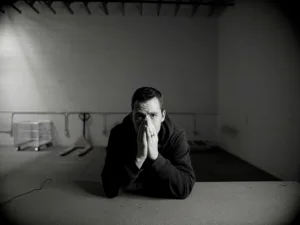When it comes to healing from trauma, finding the right therapeutic approach can feel overwhelming.
As men, we often face unique challenges in accessing therapy services that truly understand and address our specific needs.
Many therapy practices aren’t designed with men’s experiences in mind, making it harder to find the right fit for effective treatment.
Recent studies indicate that approximately 6 out of 10 men experience at least one trauma in their lifetime, yet many wait years before seeking professional help.
This hesitation is understandable but doesn’t have to define our journey.
While several trauma treatment options exist, two approaches have shown particular promise: EMDR (Eye Movement Desensitization and Reprocessing) and Brainspotting.
Both offer alternatives to traditional talk therapy, especially when words alone don’t seem enough to process deeper emotional experiences.
While Brainspotting emphasizes a focused connection between eye positions and emotional processing, EMDR therapy—supported by decades of clinical research—offers a structured, measurable approach to healing.
At Denver Men’s Therapy, we’ve witnessed how EMDR therapy can create lasting positive change, particularly for men seeking concrete, measurable results.
Let’s explore these therapeutic approaches together and understand how each might serve your healing journey.
EMDR: The Power of Eye Movement in Healing
EMDR therapy represents a breakthrough in trauma treatment that has helped countless men process difficult experiences and move forward with their lives.
Developed by psychologist Dr. Francine Shapiro in the late 1980s, EMDR has evolved into one of the most researched and validated approaches for treating trauma. With advancements like EMDR 2.0, it continues evolving as a powerful healing tool.
At Denver Men’s Therapy, we stay current with the latest developments in EMDR, including the enhanced EMDR 2.0 protocol. This advanced approach builds on the proven foundation of traditional EMDR by incorporating new insights into how our brains process traumatic memories.
What makes EMDR unique is its focus on the brain’s natural healing abilities. Rather than requiring you to talk extensively about painful experiences, EMDR uses bilateral stimulation – typically through guided eye movements – to help your brain reprocess traumatic memories.
EMDR 2.0 intensifies this process by integrating additional working memory tasks, creating a more efficient and focused therapeutic experience.
Think of working memory as your brain’s temporary processing system. During EMDR sessions, we carefully balance memory activation with processing tasks, including rapid eye movements, tapping, or other bilateral stimulation. This combination helps reduce the emotional intensity of difficult memories while keeping you in control of the process.
EMDR’s effectiveness in treating various types of trauma is well-supported by research. Bilateral stimulation – a key component of EMDR – helps the brain access and reprocess traumatic memories stored in the limbic system, the part of the brain that governs emotions and memory.
Recent advancements, including the enhanced EMDR 2.0 protocol, suggest that incorporating targeted techniques can make the process even more efficient, often requiring fewer sessions while achieving equally impactful results.
“We’ve seen remarkable progress in our male clients using EMDR,” notes our lead therapist at Denver Men’s Therapy. “The structured nature of the protocol, combined with its efficiency, often appeals to men who want concrete results while maintaining their privacy.“
Ready to Write a New Chapter?
Let’s explore EMDR therapy together at Denver Men’s Therapy.
Exploring Brainspotting: A Focused Path to Healing
Brainspotting, discovered by Dr. David Grand in 2003, represents a more recent development in trauma therapy. This approach works by identifying specific eye positions, called “brainspots,” that connect with areas of emotional activation in your brain.
This approach allows individuals to process emotional pain naturally and deeply personally by holding these fixed eye positions.
Brainspotting builds on similar principles to EMDR, particularly the connection between eye movement and emotional processing. However, unlike EMDR’s bilateral stimulation, Brainspotting focuses on maintaining a single eye position to engage the brain’s natural ability to heal.
While Brainspotting is newer and has a smaller research base compared to EMDR, early studies suggest it shows promise in treating trauma and other emotional challenges.
Understanding both approaches can help inform your therapy choices.
That said, at Denver Men’s Therapy, we’ve found that EMDR’s structured protocol and strong research foundation make it particularly effective for men seeking concrete, evidence-based approaches to healing.
Its extensive research foundation and focus on efficiency make it a reliable choice for those ready to tackle their trauma head-on while maintaining control throughout the process.
Breaking Down the Differences: EMDR vs Brainspotting
When considering trauma therapy options, understanding the key differences between EMDR and Brainspotting can help you make an informed decision about your healing journey. At Denver Men’s Therapy, we often receive questions about how these approaches compare.
Aspect | EMDR | Brainspotting |
Treatment Style | Structured, scientifically-validated protocol with advanced EMDR 2.0 options | Focused on fixed eye positions to access emotional processing, offering a more intuitive approach |
Research Base | Extensive clinical studies spanning 30+ years, WHO-recognized | Emerging research with preliminary studies showing early promise in trauma treatment |
Session Length | 60-90 minutes | 60-90 minutes |
Treatment Duration | Often 6-12 sessions, potentially fewer with EMDR 2.0 protocol | Variable duration, depending on individual needs |
Therapist Role | Guided, structured approach | More collaborative |
While both approaches aim to help process trauma, their methods and levels of scientific validation differ significantly.
Let’s explore these differences in detail to help you understand which approach better suits your needs.
Core Treatment Approaches
Understanding the fundamental difference between Brainspotting and EMDR can help inform your choice. At Denver Men’s Therapy, we specialize in EMDR therapy, which offers a systematic, proven approach to trauma processing.
EMDR follows a clear, research-backed protocol that includes eight phases of treatment. This structure provides several advantages:
- Clear treatment goals and progress markers
- Proven effectiveness for various types of trauma
- Flexibility to adjust the approach based on individual needs
- Integration of advanced techniques through EMDR 2.0
Brainspotting offers a more fluid alternative, focusing on fixed eye positions that connect with areas of emotional activation. This method allows clients to explore their emotions in an intuitive, less structured manner.
However, decades of research have supported the effectiveness of EMDR’s bilateral stimulation technique, particularly for those seeking measurable progress through a structured framework.
Our therapists have witnessed consistent success using EMDR’s structured approach, particularly with men who value clear treatment goals and a sense of control during their healing process.
Session Structure & Experience
In an EMDR session at Denver Men’s Therapy, you can expect:
- Initial assessment of specific challenges
- Guided bilateral stimulation tailored to your needs
- Regular progress monitoring
- Integration of both traditional and advanced EMDR techniques
- Clear feedback and adjustment of approach as needed
For comparison, Brainspotting sessions typically involve:
- Finding and maintaining specific eye positions
- Less structured processing time
- A more fluid and open-ended approach to trauma work
While both approaches can be effective, many of our clients find EMDR’s structured approach provides a sense of control and measurable progress. For men navigating trauma, this structure can be particularly significant, ensuring the therapeutic process feels safe, guided, and goal-oriented.
Effectiveness for Different Trauma Types
Research and clinical experience have shown that different trauma therapies may be more effective for specific types of experiences.
At Denver Men’s Therapy, we’ve seen particularly strong results using EMDR for various male-specific challenges:
PTSD and Complex Trauma
- EMDR’s proven track record in treating PTSD is backed by extensive research, including military and first responder studies.
- The structured EMDR protocol, especially with 2.0 enhancements, helps break down complex trauma into manageable components, reducing symptoms effectively.
- Brainspotting, while newer, has shown potential in accessing deep-seated emotions and may be a helpful option for those seeking a more exploratory approach.
Male-Specific Trauma Responses
- Workplace Pressure and Performance: EMDR’s targeted approach helps address performance anxiety and work-related stress without requiring extensive verbal processing.
- Military/First Responder Experiences: Our specialized EMDR protocols are particularly effective for operational stress and trauma. On the other hand, Bzzzrainspotting can be valuable for individuals struggling to verbalize their experiences or emotions tied to high-stakes environments.
- Societal Expectations: EMDR helps process emotions while maintaining a sense of control, addressing common concerns about vulnerability.
Relationship and Family Trauma
- EMDR’s systematic approach helps process relationship patterns and attachment issues.
- The structured protocol allows for processing deep emotional content while maintaining comfortable boundaries, which can be critical for men working through childhood experiences that impact current relationships.
- Brainspotting may appeal to those who prefer a more fluid exploration of emotional dynamics, especially when tackling relational patterns tied to unresolved trauma.
Practical Considerations
When choosing a trauma therapy approach, several practical factors come into play:
Aspect | What to Know |
Treatment Planning & Timeline |
|
Professional Expertise |
|
Accessibility & Format |
|
Cost Consideration |
|
Ready to explore which trauma therapy approach might work best for you?
Schedule a consultation with our trauma-informed therapists at Denver Men’s Therapy.
Beginning Your Healing Journey with EMDR
The path to healing through EMDR therapy is unique for each person, and at Denver Men’s Therapy, we understand that taking this first step requires courage.
Understanding what lies ahead can help you feel more prepared and confident about starting your therapy journey.
Before You Begin
Many men ask us how to prepare for EMDR therapy. Here’s what we’ve found helpful:
- Getting adequate rest before sessions
- Taking time to journal or reflect on key areas of stress or trauma you’d like to address
- Understanding that healing is a process, not a race
- Knowing you remain in control throughout the treatment
- Recognizing that different people respond differently to therapy
During Your EMDR Treatment
Your therapy experience will typically include:
- A structured approach that respects your pace
- Regular check-ins about your comfort level
- Integration of traditional and advanced EMDR 2.0 techniques
- Building on your progress with measurable goals
- Adjustments based on your responses and needs
Between Sessions
Processing continues between EMDR sessions, and this is normal. You might notice:
- New awareness of patterns and responses
- Changes in how you view past events
- Improved ability to manage stress and regulate emotions
- Better sleep or increased energy levels
- Changes in how you approach daily challenges or triggers
It’s also normal to feel emotionally or physically fatigued as your brain continues processing. Remember, this is part of the healing journey, and our experienced EMDR therapists are here to guide you through each step, ensuring you have the support and tools needed for effective healing.
Choosing Between EMDR vs Brainspotting
Making an informed decision about trauma therapy is crucial for your healing journey. While both approaches have merit, understanding how each aligns with your specific needs can help guide your choice.
Understanding Common Barriers
As men, we often face unique challenges when considering therapy:
- Concerns about appearing vulnerable
- Uncertainty about the therapy process
- Balancing therapy with work demands
- Questions about effectiveness
Research shows that structured approaches like EMDR can help address these concerns, offering:
- Clear progress markers
- Defined treatment timelines
- Evidence-based results
- Professional boundaries
For those who prefer a less structured approach, Brainspotting allows for a more intuitive exploration of emotions, which some men may find empowering.
Key Considerations for Your Decision
Consider these factors when making your choice:
Factor | What to Consider |
Treatment Approach |
|
Time & Commitment |
|
Processing Style |
|
Professional Support |
|
Making an Informed Choice
When evaluating your options, consider:
- Your comfort with different therapeutic approaches
- Treatment timeline preferences
- The importance of research-backed methods
- Available support systems
For many men, EMDR’s structured, evidence-based approach offers a comfortable balance of effective treatment and professional boundaries. The protocol’s clear framework and established effectiveness can provide reassurance while maintaining privacy and dignity throughout the healing process.
However, for men seeking a more flexible and intuitive healing process, Brainspotting offers an alternative path to recovery.
At Denver Men’s Therapy, our experienced EMDR therapists are here to help you navigate your healing journey, offering personalized guidance and support every step of the way.
Your Path Forward: Final Thoughts
Choosing the right therapy is a deeply personal decision, and by exploring both EMDR and Brainspotting, you’ve taken a decisive step toward reclaiming control over your life.
Each approach offers unique strengths, and understanding what aligns with your needs is key to building a healing journey that feels right for you.
For men seeking structure, clarity, and proven results, EMDR therapy provides a clear path forward. Its research-backed protocol and measurable progress markers appeal to those who value efficiency and a sense of control during their healing process.
Brainspotting, on the other hand, offers a more fluid, exploratory approach that may resonate with individuals who prefer an intuitive and client-led experience.
At Denver Men’s Therapy, we’ve seen firsthand how EMDR helps men process trauma, build resilience, and regain confidence, all while maintaining their privacy and dignity.
Whether you’re navigating the challenges of PTSD, workplace stress, or relationship trauma, our therapists are here to guide you through every phase of your healing journey with the care and expertise you deserve.
Taking the next step may feel daunting, but it’s a testament to your strength and commitment to yourself. Wherever your path leads, remember: healing is a journey, and you don’t have to take it alone.
Ready to explore how EMDR can support your healing journey?
FAQs
1. Can I switch between EMDR and Brainspotting during my treatment journey?
While both approaches are effective, therapists recommend initially committing to one method. This allows you to fully experience and benefit from the chosen approach’s unique protocol. Any consideration about switching should be discussed with your therapist based on your progress and needs.
At Denver Men’s Therapy, we specialize in EMDR therapy and can help you understand if this evidence-based approach aligns with your healing goals.
2. Are there any conditions or situations where one therapy is recommended over the other?
Both approaches effectively treat trauma, with some variations in their application:
- EMDR may be preferred for specific trauma events and anxiety
- Brainspotting might be chosen for body-based trauma and performance issues
The best choice depends on your comfort with each approach’s methodology.
3. What happens if I feel overwhelmed during either type of therapy session?
Both approaches prioritize your safety and comfort. Your therapist will teach you grounding techniques before processing begins, and you can pause or adjust the pace anytime. You remain in control throughout either process.
4. How should I prepare for my first therapy session?
Regardless of the approach you choose:
- Schedule time for rest afterward
- Wear comfortable clothing
- Note any questions you have
- Maintain regular meals and hydration
- Get adequate sleep the night before
5. Can these therapies be effectively delivered through online/teletherapy sessions?
Yes, both EMDR and Brainspotting have been adapted successfully for online delivery. Therapists use specialized virtual tools and maintain the same safety protocols as in-person sessions. Many clients find virtual sessions equally effective and convenient.
6. Can Brainspotting and EMDR be used together?
While each approach has unique benefits, they’re typically used separately to maintain clarity in the healing process. Your therapist might draw from both based on their training and your needs.
7. Which therapy is more suitable for young adults: Brainspotting or EMDR?
Young adults may connect differently with each approach:
Some prefer EMDR’s structured protocol, while others resonate with Brainspotting’s fluid process. Remember, your comfort and preference should guide the choice.
8. Is Brainspotting faster than EMDR?
Treatment duration varies by individual needs rather than the approach chosen. Both methods work at a pace that feels right for you, prioritizing effective healing over speed.
9. Are there risks or side effects with these therapies?
Both approaches may lead to temporary effects during processing:
- Increased emotional awareness
- Vivid dreams or memories
- Physical sensations
- Temporary fatigue
These are normal parts of the healing process, and your therapist will help you understand and manage any responses.









